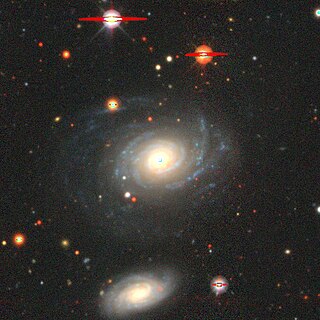
NGC 1 is an intermediate spiral galaxy of the morphological type Sbc, located in the constellation of Pegasus. It was discovered on 30 September 1861 by Heinrich d'Arrest.

The Lyon-Meudon Extragalactic Database (LEDA) was a database of galaxies, created in 1983 at the Lyon Observatory. Each galaxy had a number assigned to it, which is now known as its PGC number. The Principal Galaxies Catalogue (PGC), published in 1989, was based on the Lyon-Meudon Extragalactic Database and contained cross-identifications for it. LEDA was eventually merged with Hypercat to become HyperLEDA in 2000, itself also known as PGC2003. LEDA originally contained information on more than 60 parameters for about 100,000 galaxies, and now contains information on over 3 million celestial objects, of which about 1.5 million are galaxies. The database allows astronomers around the world access to its information.

NGC 5970 is a large barred-spiral galaxy located about 90 million light years away in the constellation Serpens Caput. It appears to have two satellite or companion galaxies. It is a member of the Virgo Cluster of galaxies. It was discovered on March 15, 1784, by the astronomer William Herschel.

NGC 75 is a lenticular galaxy estimated to be about 260 million light-years away in the constellation of Pisces. It was discovered by Lewis A. Swift from the USA in 1886 and its magnitude is 13.2.
NGC 7759 is a lenticular galaxy in the constellation Aquarius. It is located about 340 million light-years away from the Sun. It was discovered independently by American astronomers Lewis A. Swift and Francis Preserved Leavenworth.

NGC 166 is a spiral galaxy located around 2.6 million light-years away in the constellation Cetus, with an apparent magnitude of 15.18. It was discovered by Francis Preserved Leavenworth in 1886.

NGC 333 is a lenticular galaxy located approximately 755 million light years away in the constellation Cetus. It was discovered in 1877 by Wilhelm Tempel. It is recorded as NGC 333 in the New General Catalogue. It has a companion galaxy, named PGC 3073571, which is presumed to be a physical pair with NGC 333.

LEDA 135657 is a distant low surface brightness spiral galaxy located about 570 million light-years away in the constellation Cetus. It has an estimated diameter of 97,000 light-years.
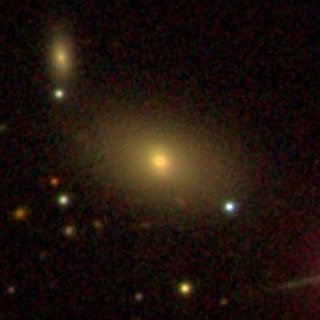
NGC 6054 is a barred lenticular galaxy located about 460 million light-years away in the constellation Hercules. It was discovered by astronomer Lewis Swift on June 27, 1886. It was then rediscovered by astronomer Guillaume Bigourdan on June 1, 1888. PGC 57073 is often misidentified as NGC 6054. NGC 6054 is a member of the Hercules Cluster.

NGC 679 is an elliptical or a lenticular galaxy located 210 million light-years away in the constellation Andromeda. The galaxy was discovered by astronomer William Herschel on September 13, 1784 and is a member of Abell 262.

NGC 688 is a barred spiral galaxy with starburst activity located 190 million light-years away in the constellation Triangulum. It was discovered by astronomer Heinrich d'Arrest on September 16, 1865 and is a member of the galaxy cluster Abell 262.
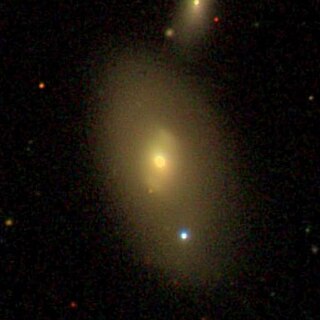
NGC 4296 is a barred lenticular galaxy located about 200 million light-years away in the constellation Virgo. It was discovered by astronomer William Herschel on April 13, 1784. It forms a pair with NGC 4297, and both galaxies are listed as CGCG 042-041, and KPG 331.

NGC 4380 is an unbarred spiral galaxy located in the constellation of Virgo. Located about 52.2 million light-years away, is a member of the Virgo Cluster, a large galaxy cluster. It was discovered on March 10, 1826, by the astronomer John Herschel.
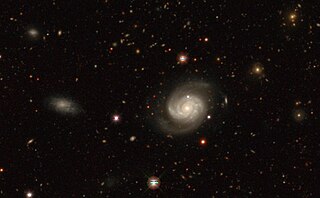
NGC 7812 as is an intermediate spiral galaxy in the constellation Sculptor. The galaxy was discovered on 25 September 1865 by Sir John Hershel. At its widest, it measures approximately 100-thousand light years across, and is 315 million light years away from Earth.
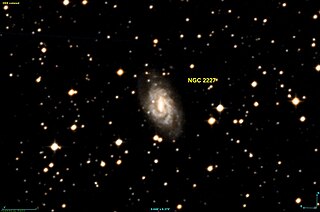
NGC 2227 is a barred spiral galaxy with a morphological type of SB(rs)c located in the direction of the Canis Major constellation. It was discovered on January 27, 1835, by John Herschel.
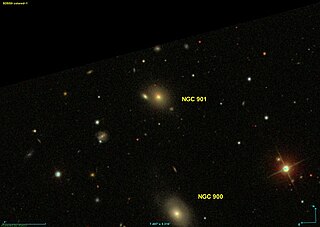
NGC 901 is an elliptical galaxy in the constellation Aries. It is estimated to be 441 million light years from the Milky Way and has a diameter of approximately 50,000 ly. NGC 901 was discovered on September 5, 1864, by Albert Marth.

NGC 2328 is a low-luminosity, early-type (lenticular) galaxy. It is located in the Puppis constellation. NGC 2328 is its New General Catalogue designation. It is located about 59 million light-years away from the Sun.

NGC 731 is an elliptical galaxy located in the constellation of Cetus about 172 million light-years away from the Milky Way. It was discovered by William Herschel on January 10, 1785. It has a luminosity of 3.9×1010 L☉.

NGC 5473 is a lenticular galaxy in the constellation Ursa Major. It was discovered on April 14, 1789, by the astronomer William Herschel. Located roughly 85 million light-years away, it is part of a small galaxy group including NGC 5475 and NGC 5485.

NGC 4343 is an unbarred spiral galaxy in the constellation Virgo. It was discovered by the astronomer William Herschel on April 13, 1784. At a distance of 80 million light-years, it is located in the Virgo Cluster. It contains an active galactic nucleus.




















